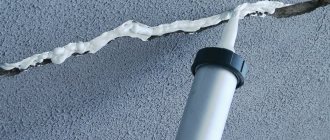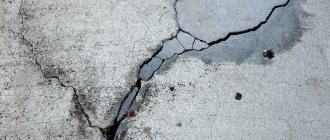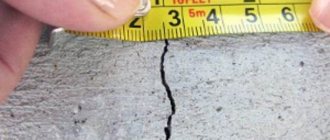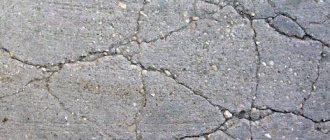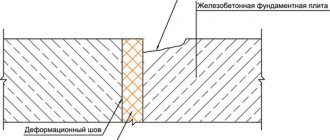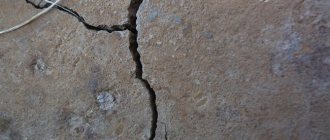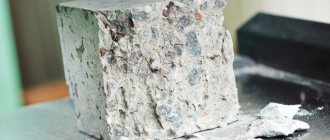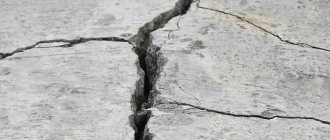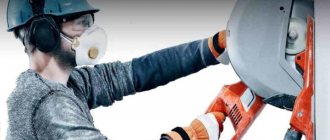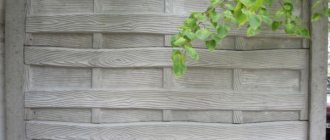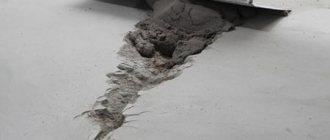- 1 Why do defects appear?
- 2 Types
- 3 Damage to roof slabs
- 4 Farm violations
- 5 Gaps in beams
- 6 Other defects
- 7 The process of eliminating cracks
- 8 Conclusion
There are quite a lot of defects in concrete surfaces. Errors in the production process, poor quality of materials, design inaccuracies, violation of operating requirements - this is not the entire list of damages. The most common defect in concrete and reinforced concrete structures are cracks. Analysis of the origin and repair possibilities are important issues in the problem of crack formation.
Why do defects appear?
The causes of cracks are varied. The most common include:
- high ambient temperature;
- non-compliance with the layer thickness recommended by construction standards;
- violations in working with plasticizers;
- errors in the method of strengthening the load-bearing capacity of metal;
- errors in design documentation;
- accidents, natural disasters.
Defects often appear during the drying process of a reinforced concrete structure. As concrete dries, it loses its liquid and contracts. The process is difficult to control, especially when working outdoors.
The resulting damage does not necessarily indicate the destruction of the structure. The moment of occurrence, the width of the defect, the location - facts that need to be paid attention to in order to understand how serious the problem is. The final cause of the problem becomes known after thorough investigation. In each individual case, it is necessary to involve a qualified specialist, not only to find out the cause of the problem, but also to eliminate it.
Return to contents
Causes and elimination of cracks in reinforced concrete structures
There are quite a lot of defects in concrete surfaces. Errors in the production process, poor quality of materials, design inaccuracies, violation of operating requirements - this is not the entire list of damages. The most common defect in concrete and reinforced concrete structures are cracks. Analysis of the origin and repair possibilities are important issues in the problem of crack formation.
Kinds
Over time, during operation, various defects appear in reinforced concrete structures.
The various reasons that result in defects are divided according to characteristic criteria. Cause:
- mechanical damage during operation of the facility;
- damage to structures during transportation, loading, installation;
- the occurrence of a defect as a result of compressive forces;
- technological defect (shrinkage, poor compaction);
- result of reinforcement corrosion.
Reason value:
- indicates the emergency condition of the structure;
- moisture penetration into reinforced concrete structures increases;
- wear and tear of a structure susceptible to corrosion;
- violations that cause concern.
The following types of formations damage reinforced concrete structures:
- through wedge-shaped;
- through-lap;
- non-through wedge-shaped;
- through parallel;
- inclined closed;
- longitudinal non-through.
By analyzing a crack based on the nature of its occurrence and the degree of opening, it is possible to establish the true cause and draw a conclusion about the dangerous condition of the structure. The force influence on the structure creates damage, which is located perpendicular to the main line of application of the force. The surface, under the influence of compression, becomes covered with cracks in a chaotic manner, forming a nodal connection. Such cracks are called shrinkage cracks. Corrosion cracks are located on structures along the metal rod.
Return to contents
Causes of cracks
The formation of any defects in concrete signals a change in the strength of the structure, not for the better. Typically, cracking of the monolith occurs after a few years, but this often happens with new buildings. Sometimes it can be noted that soon after construction the concrete mass is covered with a network of small cracks. The reason is the harmful influence of external factors or internal overvoltage of the structure.
The occurrence of cracks in concrete structures
Cracks that are the result of external influences are often dangerous and pose a serious threat to the load-bearing capacity of the product. They arise due to the following phenomena:
- Bend. Cracks form perpendicular to the reinforcement bars, which are subject to bending loads. Defects begin in the center of the most deformed section of the rods.
- Shift. If a shear force is applied diagonally to the longitudinal axis of the rod, cracks appear directly from the point of application of such force.
- Stretching. This type of stress can coincide with the axis of the reinforcement or act parallel to it. As a rule, cracks in this case are transverse.
Often, a scattering of cracks on a concrete structure is a consequence of improper installation of reinforcement. The same problems can be caused by incorrect installation of anchors, which causes detachment of the upper protective layer. Another common prerequisite for cracking of concrete is its strong cooling due to a sharp temperature difference on the surface and in the depths of the structure. This happens when it cools quickly under the influence of water, air, or when it quickly dries under the sun's rays.
Other possible causes of cracks in concrete are:
- subsidence or swelling of the soil, the presence of unforeseen uneven terrain;
- too much soil moisture or soil rising under the influence of moisture;
- soil compression due to the operation of the drainage system;
- early start of operation of the structure, when it has not yet completely hardened;
- incorrect selection of the cross-section of reinforcing bars or violation of their placement points;
- too little reinforcement;
- poor compaction of concrete and the appearance of air cavities inside;
- severe rusting of fittings;
- impact of seismic factor;
- violation of the ratio of cement, sand, water in the solution;
- excessively long transportation of concrete to the pouring site;
- incorrect calculation of the load on the concrete structure;
- incorrect method of dismantling formwork;
- completion of additional structures to the main facility without taking into account the specifics of their interaction;
- incorrect choice of cement brand when making mortar.
Crack due to foundation subsidence
Damage to vault slabs
Crack in a reinforced concrete monolithic floor slab.
The floors of industrial structures are located in difficult conditions and experience enormous loads, force and chemical influences. The consequence is surface wear and damage. During the hardening process, small damage may occur in the concrete. Shrinkage cracks look like a mesh and are not dangerous.
Defects that appear during the operation of structures, gradually lengthening and expanding, lead to deformation damage. The appearance of characteristic signs indicates serious violations during construction and overstressing of floor slabs. The problem must be eliminated by replacing the structure; if this is not possible, they will install a retaining wall and remove all heavy things.
Floor deflection also causes problems. The condition of reinforcement and concrete is assessed. An insufficient amount of reinforcement or its incorrect location leads to a force crack. Expansion of the hole greater than 3 mm requires reinforcement with additional reinforcement.
Return to contents
Methods of protection against shrinkage cracking
In order to prevent shrinkage cracks in concrete, it is necessary to reduce the shrinkage of the cement stone, prevent drying out of the surface layer of concrete, and in the case of massive structures, slow down hardening. You can read more about this in the article “Caring for concrete after concreting“.
It is possible to reduce the amount of shrinkage if you correctly select the parameters of the concrete mixture, especially its mobility, while at the same time reducing the water-cement ratio.
In order to ensure the necessary mobility of the concrete mixture, especially for mixtures of grade P3 and higher in workability, concrete must be manufactured with the mandatory use of water-reducing additives - plasticizers. Plasticizers and superplasticizers are the mechanism that allows you to obtain highly fluid concrete mixtures and eliminate problems with cracks in concrete. In addition to plasticizers, it is very important to choose the recipe and the ratio of components so that there is enough solution part.
When comparing a concrete mixture with mobility P4 with and without the use of a superplasticizer:
— the amount of shrinkage after 7 days of hardening without plasticizer was 2 cm per 1 meter, which is 2%.
— when adding a superplasticizer, the shrinkage after 7 days of hardening was 0.2 cm per 1 m, which is 0.2%.
Another way to avoid shrinkage cracks is to entrain 4.5 ± 1.5% air into concrete (use of an air-entraining additive - for example, aeroplastic). An air bubble in the structure of the cement stone is a trap for a developing crack. Once the crack enters the bubble, it stops. The dosage of air-entraining additives for heavy concrete is 0.03÷ 0.15% of the weight of cement in terms of dry matter, air entrainment is from 2 to 6%.
It is possible to prevent the surface layer of concrete from drying out through a number of technological measures. To obtain good quality concrete, it is necessary to create a moist environment in summer and a warm and humid environment in winter for it to harden. After laying the concrete mixture in the summer, its surface must be protected from drying out, and during the first hours of hardening, from rain.
For this purpose, after concreting is completed, horizontal surfaces are covered with moisture-absorbing materials: a layer of sand at least 5 cm thick, straw mats, sawdust, matting, which are constantly moistened. You can use plastic film for these purposes, covering the concrete surface with it after the next watering.
In the first days, the vertical walls of the foundation are protected from drying out by the formwork, but it also needs to be moistened. After removing the formwork, the side walls of the foundation should be watered in the same way as the horizontal surface.
Concrete watering period: at outdoor temperatures above 15ºС - at least 15 days; at temperatures from 10 to 15ºС - at least 10 days. At lower temperatures, the timing of concrete watering is set at the work site.
The simplest method is to treat the structure with a film-forming compound.
To slow down the hydration process, special retardant additives are used. Without a retarder, the hardening process is more intense, and accordingly, shrinkage processes are more intense. Which in turn leads to increased cracking and shrinkage cracks appear.
Farm Violations
Rafter trusses have the characteristic feature of working in compression, ensuring stability and rigidity of the coating. The connected elements contribute to the emergence of a concentration of stress of different types: tensile, compressive, tangential. High concentrations contribute to the occurrence of disturbances at the junction points. Tensile stress threatens a through vertical crack, while compressive stress threatens a non-through horizontal crack.
A number of reasons influencing deformation:
- low quality concrete;
- incorrect placement of transverse reinforcement;
- displacement of the metal frame.
Return to contents
Gaps in beams
Typical cracks in the beam: 1 – normal cracks in the zone of maximum bending moment;
2 – inclined cracks in the zone of maximum shear force; 3 – cracks and fragmentation of concrete in the compressed zone of the element. Particular attention is paid to cracks that occur in places where beams are laid. A simplified connection of the truss structure threatens possible pinching of the supports, which, together with the pressure of the slabs, leads to the formation of holes. The phenomenon is rare, but cannot be restored.
The building structure is destroyed under the influence of vertical or horizontal cracks in the beams. There are several reasons for this problem. The first is shrinkage stress caused by an insufficiently strong protective layer. Poor quality of the material, violation of the temperature regime during heat treatment are the causes of problems with the beam.
The shrinkage gap is small, but air and gases pass through it, causing corrosion of the metal. Rust is a big problem with shrinkage defects, it pushes the concrete apart, widening the holes. The second reason is corrosion, which is not caused by steam. Occurs under the influence of chemical compounds that make up concrete. The degree of danger depends on the degree of corrosion development. The third reason is beam splitting. Finding a split at the end of a structure is especially dangerous; the supporting function of the elements is reduced.
Damage to beams is a direct threat to the strength of the structure.
Return to contents
The occurrence of cracks in concrete and reinforced concrete structures
Question:
Why do cracks occur in concrete structures (vertical) when formwork is removed?
Answer:
Cracks on the surface of concrete structures can form for various reasons.
Causes of cracks:
— too high a temperature (typical for rooms in which heating devices are used);
— a sufficiently large layer of the concrete surface;
— absence of polypropylene fiber and plasticizers in the concrete composition.
Cracks also occur when concrete dries, as the concrete surface shrinks as it loses water.
However, this process is very difficult to control, especially if the work is not carried out indoors.
When carrying out external work, in order to prevent too rapid drying from exposure to sunlight, it is recommended to cover the concreted surface with plastic films.
At low air temperatures, use the same recommendation.
A good effective method to help combat cracks is the method of cutting seams.
Seams are cut along the fresh concrete surface, which are a kind of separators for parts of this surface.
Experts recommend doing this cutting at normal air temperatures approximately 12 hours after laying the concrete, and 24 hours later at low temperatures.
This shows that the time required for cutting seams is reduced if the air temperature is high.
The depth of the cut joints should be approximately 1/4-1/3 of the thickness of the concrete surface.
In addition, you also need to take into account the distance between the cut seams; it should be from 200 to 300 centimeters. If the concreting area is large, then the seams are cut in squares.
Quite often, cracks form in a concrete surface that has not had time to gain its strength.
These shrinkage cracks often occur if the weather is hot, windy and dry.
If such weather is expected during the construction of the concrete surface, then it makes sense to use special concrete with synthetic additives (synthetic additives in the form of fibers).
It is advisable to accompany the process of grouting and laying a concrete surface by wetting the surface with water (this is done to slow down the drying process).
Non-structural (structural) cracks:
The term “non-structural cracks” refers to cracks in reinforced concrete elements for which, when they occur, the accepted safety factor is not reduced and reinforcement of the elements with additional reinforcement or concrete is not required.
There are two types of plastic shrinkage cracks.
The first, the most common, appear as a result of very rapid evaporation of moisture from the exposed surface of concrete when it is still in a plastic state.
These are commonly referred to as surface plastic shrinkage cracks.
Such cracks on a horizontal surface are formed due to the rapid evaporation of moisture from it (drying).
When the rate of evaporation exceeds the rate of water rising to the surface (known as dewatering), the surface of freshly placed concrete will undergo plastic shrinkage cracking.
The speed at which the water in the concrete mixture reaches the surface and the total amount of water depends on many factors.
Factors that are of great importance for the phenomenon under consideration:
— grain composition, moisture content, water absorption and type of aggregate used;
— total water content in the mixture;
— cement consumption;
— thickness of the concrete slab;
— characteristics of all additives used;
- the achieved degree of compaction and, consequently, the density of concrete; It is also important whether the formwork (or underlying mortar) on which the concrete was laid was moistened.
The rate of moisture evaporation from the surface also depends on a number of fairly well-studied factors:
— relative humidity;
— concrete temperature;
— ambient air temperature;
— wind speed; the degree of exposure to sun and wind on the surface of the slab.
Surface cracks during plastic shrinkage are hairline, fairly straight cracks 50-750 mm long.
They are often located perpendicular to the working fittings.
Sometimes several cracks form parallel to each other at a distance of 50-80 mm.
Cracks are usually shallow and rarely penetrate below the top of the concrete cover, although in unfavorable conditions they can be deeper and even cut right through the slab.
These cracks usually form in hot sunny weather or on dry, very windy days.
If the cracking is minor, the cracks are shallow and do not lead to destruction of the slab surface; in this case it is relatively safe.
Cracks should be repaired with Portland cement mortar and smoothed well with a brush.
Then the treated surface is covered with plastic film for at least 48 hours, securing it along the edges with strips and bars.
The use of an additive to entrain 4.5±1.5% air into concrete significantly reduces cracking from plastic shrinkage.
It is always better to prevent destruction than to correct its consequences.
If the concrete is well covered with plastic film after laying and secured around the perimeter, then cracking of the surface of freshly laid concrete during plastic shrinkage is hardly possible.
The second type of plastic shrinkage crack occurs when the hardening concrete mixture settles.
The reason for the appearance of such cracks is different from surface cracks due to plastic shrinkage.
Such cracks can be caused by two main points.
The first is the resistance of the mold surface to subsidence (compaction) of the plastic loaf under the influence of deep vibrators and gravity.
The resistance of the form restrains this movement. If the mixture does settle, and hardening has already begun, cracks are very likely to form, which, as a rule, damage the surface of the concrete.
They are wider on the surface and their depth is no more than 20-25 mm.
The second point is more serious, because cracks often reach the reinforcement.
They may be wider inside than on the surface of the concrete, and are associated with the formation of shells.
Cracks are caused by the concrete mixture getting stuck on the reinforcement, causing cracks to form as it hardens.
Appropriate adjustments in the mixture and more thorough compaction will help eliminate this cause.
It is recommended to repair cracks of this type by injecting a solution into them. Simple surface treatment is unlikely to be sufficient to ensure long service life.
If such cracks are observed in high beams and thick slabs, it is recommended to check for cavities in the concrete and take corrective action as recommended in the section of this chapter on repairing cellular concrete.
Temperature-shrinkage cracks
During setting and at the beginning of the hardening process, a significant amount of heat is released due to the chemical reaction between water and cement, which leads to an increase in the temperature of the concrete.
The degree of increase and the maximum temperature achieved, as well as the time during which this maximum is reached, and the subsequent cooling of the concrete, depend on a large number of factors.
Among them, the temperatures of the ambient air and concrete during laying are of greatest importance; the type of formwork used (wooden, plastic, steel) and the time the concrete was kept in it; ratio of exposed concrete surface, i.e. the area not protected by formwork to the volume of concrete; thickness of the section of the concreted element; the type of cement used and its content in the mixture; measures for thermal insulation of concrete after removing the formwork; holding method.
When the temperature rises, concrete expands, and when it cools, it contracts.
The temperature coefficient of expansion (compression) is determined by a number of factors, the main of which are the type of filler and the composition of the mixture.
If an element (floor, wall or covering) does not have complete freedom of deformation (which almost never happens), when the concrete cools and shrinks, thermal stresses develop in it.
The higher the degree of embedding, the greater the temperature-shrinkage stress.
These stresses, as a rule, are tensile, but compressive stresses may appear in certain parts of building structures.
Tensile stresses often exceed the tensile strength of concrete or the bond strength between concrete and reinforcement, resulting in cracking.
Temperature-shrinkage cracks cross the entire element.
Although such cracks rarely have a significant impact on the load-bearing capacity, they create points of weakness in the structure until they are properly repaired.
Shrinkage during normal drying causes these initially very small cracks to open (usually no wider than 0.05 mm).
For this reason, they are often invisible for several weeks after concreting.
The restoration method usually depends on whether there has been recent movement in the crack, i.e. does she “live”?
If such movements are not expected, then the crack can be filled with rigid material.
Otherwise, some degree of compliance should be ensured during restoration.
How this will be accomplished depends on the environment and the type of finish the element is acceptable to the customer.
In practice, the choice is made between crack injection and surface treatment, which are accompanied by high-quality sealing and application of a decorative layer.
Shrinkage cracks during drying
Shrinkage cracks during drying usually have a limited distribution.
They appear in non-load-bearing elements that do not have reinforcement or are reinforced only based on installation requirements and thin coatings, screeds and layers of plaster.
In most cases, the cause of their occurrence is considered to be poor mixture design, which is aggravated by improper aging.
The use of calcium chloride as an additive or the presence of chlorides in aggregates increases drying shrinkage.
Mistakes in mix design include using too much water or using poorly graded aggregates that contain large amounts of very fine particles.
The more fine aggregates a concrete or mortar contains, the higher the water requirement for workability.
All concrete and mortars are subject to shrinkage when drying, which leads to the opening of cracks that arose for other reasons, for example due to temperature shrinkage.
The shrinkage due to drying shrinkage at 28 days of age is approximately 25% of the value at 180 days of age.
The recovery method in each case depends on the specific features.
In topcoats, screeds and plaster layers, drying shrinkage cracks may be accompanied by warping and loss of adhesion.
Cracks are not always dangerous for concrete.
The determining factors for deciding on repairs and the method of sealing cracks are:
— the reason for the formation of cracks;
— the width of their opening and location;
— the degree of atmospheric influence on the elements.
Usually, when repairing non-structural cracks, difficulties do not arise.
However, they may appear if the crack needs to be repaired without the repair being noticeable once completed.
Since cracks are always visible up close, it is almost impossible to hide traces of repairs unless a decorative coating is applied to the entire element.
Cracks on the outer surfaces of exposed elements gradually expand and become more visible.
Such phenomena are typical primarily for concrete structures exposed to harsh weather conditions and for light-colored structures in urban environments.
In aggressive environments, cracks wider than 0.1 mm in external elements and thin surface layers should be sealed hermetically.
If there are no rust spots and the concrete does not crumble, and when tapping the crack with a hammer no voids are found, then there is reason to believe that the corrosion of the reinforcement is insignificant.
In this case, it is not recommended to open the crack during repair.
To check the condition of the reinforcement, you can cut out the concrete in several places and leave it at that.
You can also take several samples of concrete to monitor its quality and other characteristics, as well as to determine the concentration of chlorides.
The recommendations below can be used when sealing shallow cracks that appeared for various reasons and were not caused by external loads.
When the appearance of the concrete surface is not important, it is recommended to very carefully tap the entire crack line with a chisel.
This helps to identify even minor voids.
It should be noted that in this case the concrete is not cut out from the crack.
All stone fines, dust and dirt are removed with a brush, and the surface of the concrete on both sides of the crack is cleaned with a wire brush.
After such preparation, a latex solution is injected into the crack with a brush.
It is also advisable to apply the solution with a brush to the concrete surface approximately 75 mm wide on each side of the crack, i.e. onto the areas that were cleaned with a wire brush.
If necessary, another layer of solution can be applied after one or two weeks.
For exposed concrete elements, the following restoration method is proposed, which is applicable only to hairline cracks in the absence of reinforcement corrosion and concrete spalling.
First of all, you need to wash the concrete surface approximately 75 mm wide on both sides of the crack with cold water.
Then, using a wooden spatula with a rubber plate, introduce liquid mortar or cement paste into the crack.
The solution is prepared using white or a mixture of white and gray cement (depending on the color of the concrete element being restored).
The addition of white artificial rubber latex helps reduce water permeability and shrinkage.
Two weeks after completion of the repair, all concrete elements should be washed with water.
Other defects
The type of structure, its design, and calculation schemes do not affect the general characteristics of cracks. Each defect that appears indicates that this point is an accumulation of tension. We have already discussed the most common types of flaws, but this is not a complete list of all errors. Let's pay attention to the existing types of damage:
- Small cracks, hairline. Appear on the upper surface, there is no clear directionality, it is not difficult to visually determine. They do not affect the load-bearing capacity and are easily removed by covering with the solution.
- Small cracks along the metal rod. The defect is accompanied by light rust up to 5 mm, and concrete cracking near the reinforcement is possible. Load-bearing capacity is reduced by 5%, which affects the service life. It is necessary to restore the protective layer; if necessary, strengthen the defect site.
- Concrete chipping. Occurs under mechanical influence. If it occurs in a compressed zone, the bearing capacity of the elements is impaired; in a tensile zone, the bearing capacity is not impaired, but the rigidity of the structure suffers. Chips are repaired with fine-grained mortar.
- Oiling of concrete. Oil leaks in industries cause significant problems. The strength of concrete pavements is reduced by 30%. The oily layer is removed and leaks are eliminated.
- Detachment of protection. The formation of corrosion and the occurrence of splits leads to peeling of the protective layer. The condition is emergency and can be eliminated by restoring the protective coating.
- A cracked foundation puts the building in a state of disrepair. Vibration is immediately eliminated and the foundation is strengthened.
Return to contents
Classification
The size of the opening divides cracks into hairline (hairline) cracks up to 0.1 mm in size, small (up to 0.3 mm), developed (up to 0.5 mm) and large (from 1 mm).
Defects in concrete pavement can be classified according to various criteria, the main one of which is the cause of their occurrence. Here are some examples of such cracks: temperature, sediment, wear, deformation, shrinkage, structural, etc.
According to their direction, cracks can be vertical, horizontal or inclined. Another sign is depth, these include superficial and through damage. And the size of the opening divides them into hair (hair) up to 0.1 mm in size, small (no more than 0.3 mm), developed (no more than 0.5 mm) and large (1 mm and more).
For example, through ones are located along the entire transverse plane of a concrete structure. Such cracks owe their occurrence to the existing central tension. But through-hair damage is in the nature of minor superficial damage and is most often regarded as acceptable.
Crack removal process
Restoration of reinforced concrete by injection method.
A crack is not as bad as its width. Acceptable size is 3 mm. Moisture can easily seep into larger damage. In the cold season, the water freezes, widening the gap even more, and so several periods of freezing and thawing pass through. The split increases in volume, and even more moisture gets into it. Over time, water reaches the metal rod, rust appears, and as a result, the destruction of concrete.
To avoid destruction, even small cracks should be eliminated at an early stage. The concrete area is treated with cold water, and the hair formations are sealed with a solution using a spatula. Damage can be covered with any material and in different ways. The correct choice is influenced by the width of the damage, the cause, the type, and the effect on the load-bearing capacity.
If the load-bearing capacity is preserved, a restoration method called jointing is used. The crevice is tapped along its entire length in order to detect emptiness. All crumbs and chips are removed with a metal brush and the cleaned space is blown through with compressed air. The prepared surface is covered with a polymer-cement mixture, leveling it flush with the concrete surface.
Lost load-bearing capacity is restored by injecting polymer resins directly into the crack. A modern mortar based on epoxy resin is capable of bonding even to wet concrete. The operating temperature range is very wide, they have insignificant shrinkage, and fill the space efficiently.
Return to contents
Shrinkage cracks
Temperature-shrinkage cracks were identified in certain areas of monolithic foundations.
Cracks on the unformed surfaces of concrete structures indicate a violation of the temperature and humidity conditions and non-compliance with protective measures during the initial period of concrete hardening, which is a failure to comply with the requirements of SNiP 3.03.01-87 “Load-bearing and enclosing structures” clause 2.15 and clause 2.16. Section “Currenting and maintenance of concrete”.
“2.15. During the initial period of hardening, concrete must be protected from precipitation or moisture loss, and subsequently maintain temperature and humidity conditions to create conditions that ensure an increase in its strength.
2.16. Measures for the care of concrete, the order and timing of their implementation, control over their implementation and the timing of stripping of structures must be established by the PPR.”
This type of defect, according to the classifier of the main types of defects in construction and the building materials industry, is critical (see Classifier, paragraph 52, paragraph 229).
| №№ | Deviations from design decisions and violations of regulatory requirements, qualified as defects | Classification of defects according to GOST 15467-79 | Defect detection method |
| 1 | 2 | 3 | 4 |
| 47. | Failure to take concrete care measures in winter and summer | critical | On-site inspection. Work production log data. |
This type of defect, according to expert opinion, is a consequence of non-compliance with the required regulatory measures for the care of concrete.
- Examination of a pile foundation - Construction examination of a monolithic foundation in order to determine the quality of construction and installation work and determine the cost of eliminating identified defects and deficiencies.
- Violation of the protective layer of reinforcement - In some places the protective layer of vertical reinforcement is not provided. In some places the protective layer of concrete is 10 mm, with reinforcement bars with a diameter of 14 mm.
- Foundation slope - There is a general foundation slope of more than 20 mm over the entire length of the verified section, the horizontal plane of the pile foundation. The deviation between the verified points of the foundation support surface reaches 30mm. In accordance with SNiP 3.03.01-87 “Load-bearing and enclosing structures” in clause 2.113.
- Shrinkage cracks in the foundation - Shrinkage cracks Temperature-shrinkage cracks have been identified in certain areas of monolithic foundations. Cracks on the unformed surfaces of concrete structures indicate a violation of the temperature and humidity conditions and non-compliance with protective measures during the initial period of concrete hardening, which is a failure to comply with the requirements of SNiP 3.03.01-87 “Load-bearing and enclosing structures” clause 2.15 and clause 2.16. Section “Currenting and maintenance of concrete”.
stroitelnaja-jekspertiza.ru
